《儿科学》课程教学资源(授课教案)07 Bronchopneumonia
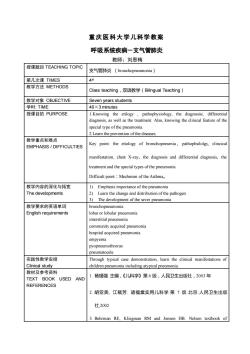
重庆医科大学儿科学教案呼吸系统疾病一支气管肺炎教师:刘恩梅授课题目TEACHINGTOPIC支气管肺炎(bronchopneumonia)第几次课TIMES4s教学方法METHODSClas teaching ,双语教学( Bilingual Teaching)教学对象OBJECTIVESeven vears studen学时:TIME40×3minutes授课目的PURPOSE1.Knowing the etilogy , pathophysiology, the diagnosisi, dfferentialdiagnosis, as well as the treatment. Also, knowing the clinical feature of thespecial typeofthepneumoni2.Learn the prevention of the diseas教学重点和难点point:the etiology of bronchopneumia、pathophsilolgy,clincicaLeEMPHASIS / DIFFICULTIESmanifestation,chest X-ray、the diagnosis and differential diagnosis、theeatment and the special types ofthepneumoniaDifficult point : Mechnism of the Asthma.教学内容的深化与拓宽1)Emphesis importance of the pneumoniaThedevelopments2Learn thechange and distributionofthe pathogen3)The development of the sever pneumonia教学要求的英语单词bronchopneumoniaEnglish requirementslobar or lobular pneumoniainterstitial pneumoniacommunity acquired pneumoniahospital acquired pneumoniaempyemapyopneumothroraxpneumatocele实践性教学安排Through typical case demonstration, learn the clinical manifestations ofClinical studychildrenpeumoniaincludingatypicalpeumon教材及参考资料杨锡强主编,《儿科学》第6版,人民卫生出版社,2003年TEXT BOOK USED ANDREFERENCES2.胡亚美,江载芳.诸福棠实用儿科学.第7版.北京:人民卫生出版社,20023. Behrman RE, Kliegman RM and Jenson HB. Nelson textbook of
重庆医科大学儿科学教案 呼吸系统疾病-支气管肺炎 教师:刘恩梅 授课题目 TEACHING TOPIC 支气管肺炎 (bronchopneumonia) 第几次课 TIMES 4 st 教学方法 METHODS Class teaching,双语教学(Bilingual Teaching) 教学对象 OBJECTIVE Seven years students 学时: TIME 40×3 minutes 授课目的 PURPOSE 1.Knowing the etilogy , pathophysiology, the diagnosisi, differential diagnosis, as well as the treatment. Also, knowing the clinical feature of the special type of the pneumonia. 2.Learn the prevention of the diseases. 教学重点和难点 EMPHASIS / DIFFICULTIES Key point: the etiology of bronchopneumia 、 pathophsilolgy, clincical manifestation, chest X-ray、the diagnosis and differential diagnosis、the treatment and the special types of the pneumonia Difficult point:Mechnism of the Asthma。 教学内容的深化与拓宽 The developments 1) Emphesis importance of the pneumonia 2) Learn the change and distribution of the pathogen 3) The development of the sever pneumonia 教学要求的英语单词 English requirements bronchopneumonia lobar or lobular pneumonia interstitial pneumonia community acquired pneumonia hospital acquired pneumonia empyema pyopneumothrorax pneumatocele 实践性教学安排 Clinical study Through typical case demonstration, learn the clinical manifestations of children pneumonia including atypical pneumonia. 教材及参考资料 TEXT BOOK USED AND REFERENCES 1. 杨锡强 主编,《儿科学》第 6 版,人民卫生出版社,2003 年 2. 胡亚美, 江载芳. 诸福棠实用儿科学.第 7 版.北京:人民卫生出版 社,2002 3. Behrman RE, Kliegman RM and Jenson HB. Nelson textbook of
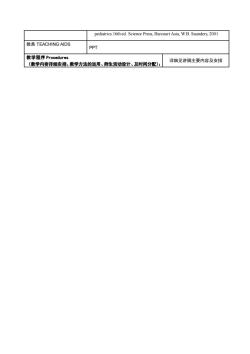
ediatrics.thd. Science Pre, Harourt Aia W. Saunders, 200教具TEACHINGAIDSPPT教学程序Procedures详细见讲稿主要内容及安排(教学内容详细安排、教学方法的运用、师生活动设计、及时间分配)
pediatrics.16th ed. Science Press, Harcourt Asia, W.B. Saunders, 2001 教具 TEACHING AIDS PPT 教学程序 Procedures (教学内容详细安排、教学方法的运用、师生活动设计、及时间分配): 详细见讲稿主要内容及安排
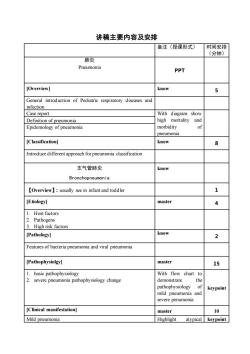
讲稿主要内容及安排备注(授课形式)时间安排(分钟)肺炎PneumoniaPPTknow[Overview]5General introduction of Pediatricrespiratory diseases andinfectionWith diagram showCase reporthigh mortality andDefinition of pneumoniamorbidity0Epidemology of pneumoniapneumoniknow[Classification)]8Introduce d fferent approach for pneumonia classification支气管肺炎knowBronchopneumonia1[Overview] : usually see in infant and toddler[Etiology]master41. Host factors2. Pathogens3.Highriskfactorsknow[Pathology]2Features of bacteria pneumonia and viral pneumoniamaster[Pathophysiolgy]15With flow chart to1. basic pathophysiologysevere pneumonia pathophysiology change demonstratethe pathophysiologyotkeypointmid pneumonia andsevere penumonia[Clinical manifestation]master10Mild pneumoniaHighlightatypical keypoint
讲稿主要内容及安排 备注(授课形式) 时间安排 (分钟) 肺炎 Pneumonia PPT [Overview] know 5 General introduction of Pediatric respiratory diseases and infection Case report With diagram show high mortality and morbidity of pneumonia Definition of pneumonia Epidemology of pneumonia [Classification] know 8 Introduce different approach for pneumonia classification 支气管肺炎 Bronchopneumonia know 【Overview】:usually see in infant and toddler 1 [Etiology] master 4 1. Host factors 2. Pathogens 3. High risk factors [Pathology] know 2 Features of bacteria pneumonia and viral pneumonia [Pathophysiolgy] master 15 1. basic pathophysiology 2. severe pneumonia pathophysiology change With flow chart to demonstrate the pathophysiology of mild pneumonia and severe penumonia keypoint [Clinical manifestation] master 10 Mild pneumonia Highlight atypical keypoint
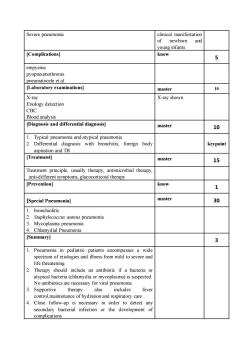
clinical manifestationSevere pneumoniaof newbormandyoung infants[Complications]know5empyemapyopneumothroraxpneumatocele et alLaboratory examinations]master10 X-rayX-ray shownEtiology detectionCBCBlood analysisDiagnosis and differential diagnosis]master101. Typical pneumonia and atypical pneumoniaDifferential diagnosis with bronchitis, foreign body2keypointaspiration and TB[Treatment]master15Treatment principle, usually therapy, antimicrobial therapy,anti-different symptoms, glucocorticoid therapyknow[Prevention]1master30 [Special Pneumonia]1. bronchiolitis12.Staphylococcus aureus pneumonia3.1Mycoplasma pneumonia4.Chlamydial Pneumonia[Summary]31.Pneumonia in pediatric patients encompasses a widespectrum of etiologies and illness from mild to severe andlife threateningTherapy should include an antibiotic if a bacteria oratypical bacteria (chlamydia or mycoplasma) is suspected.No antibiotics are necessary for viral pneumoniaalsoincludesSupportivetherapyfevercontrol,maintenance of hydration and respiratory careClose follow-up is necessary in order to detect anysecondary bacterial infection or the development ofcomplications
Severe pneumonia clinical manifestation of newborn and young infants [Complications] know 5 empyema pyopneumothrorax pneumatocele et al. [Laboratory examinations] master 10 X-ray Etiology detection CBC Blood analysis X-ray shown [Diagnosis and differential diagnosis] master 10 1. Typical pneumonia and atypical pneumonia 2. Differential diagnosis with bronchitis, foreign body aspiration and TB keypoint [Treatment] master 15 Treatment principle, usually therapy, antimicrobial therapy, anti-different symptoms, glucocorticoid therapy [Prevention] know 1 [Special Pneumonia] master 30 1. bronchiolitis 2. Staphylococcus aureus pneumonia 3. Mycoplasma pneumonia 4. Chlamydial Pneumonia [Summary] 3 1. Pneumonia in pediatric patients encompasses a wide spectrum of etiologies and illness from mild to severe and life threatening 2. Therapy should include an antibiotic if a bacteria or atypical bacteria (chlamydia or mycoplasma) is suspected. No antibiotics are necessary for viral pneumonia 3. Supportive therapy also includes fever control,maintenance of hydration and respiratory care 4. Close follow-up is necessary in order to detect any secondary bacterial infection or the development of complications
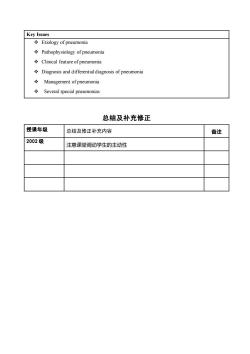
Key Issues*Etiology of pneumonia→ Pathophysiology of pneumonia*Clinical feature of pneumonia+ Diagnosis and differential diagnosis of pneumonia*Management of pneumoniaSeveral special pneumonias总结及补充修正授课年级总结及修正补充内容备注2002级注意课堂调动学生的主动性
Key Issues ❖ Etiology of pneumonia ❖ Pathophysiology of pneumonia ❖ Clinical feature of pneumonia ❖ Diagnosis and differential diagnosis of pneumonia ❖ Management of pneumonia ❖ Several special pneumonias 总结及补充修正 授课年级 总结及修正补充内容 备注 2002 级 注意课堂调动学生的主动性
按次数下载不扣除下载券;
注册用户24小时内重复下载只扣除一次;
顺序:VIP每日次数-->可用次数-->下载券;
- 《儿科学》课程教学大纲 Teaching Outline for Pediatrics Course(英文).pdf
- 《临床生物化学》课程教学资源(PPT课件)第十九章 自动临床生物化学分析仪的应用及评价.ppt
- 《临床生物化学》课程教学资源(PPT课件)第十八章 治疗药物浓度监测.ppt
- 《临床生物化学》课程教学资源(PPT课件)第十七章 妊娠的生物化学检验.ppt
- 《临床生物化学》课程教学资源(PPT课件)第十六章 肿瘤标志物的生物化学检验.ppt
- 《临床生物化学》课程教学资源(PPT课件)第十五章 神经系统疾病的生物化学检验.ppt
- 《临床生物化学》课程教学资源(PPT课件)第十四章 消化系统疾病的生物化学检验.ppt
- 《临床生物化学》课程教学资源(PPT课件)第十三章 内分泌疾病的生物化学检测.ppt
- 《临床生物化学》课程教学资源(PPT课件)第十二章 心血管系统疾病的生物化学检测.ppt
- 《临床生物化学》课程教学资源(PPT课件)第十一章 肾功能损伤的生物化学检验.ppt
- 《临床生物化学》课程教学资源(PPT课件)第十章 肝胆疾病的生物化学检验.ppt
- 《临床生物化学》课程教学资源(PPT课件)第九章 营养状况的评估及的生物化学监测.ppt
- 《临床生物化学》课程教学资源(PPT课件)第八章 微量元素与维生素异常的生物化学检验.ppt
- 《临床生物化学》课程教学资源(PPT课件)第七章 骨代谢紊乱及相关元素的生物化学检验.ppt
- 《临床生物化学》课程教学资源(PPT课件)第六章 电解质和酸碱平衡紊乱的生物化学检验.ppt
- 《临床生物化学》课程教学资源(PPT课件)第五章 血浆脂蛋白代谢紊乱的生物化学检验.ppt
- 《临床生物化学》课程教学资源(PPT课件)第四章 糖代谢紊乱的生物化学检验.ppt
- 《临床生物化学》课程教学资源(PPT课件)第三章 血浆蛋白质与含氮化合物的生物化学检验.ppt
- 《临床生物化学》课程教学资源(PPT课件)第二章 生物化学检验中的诊断酶学.ppt
- 《临床生物化学》课程教学资源(PPT课件)第一章 绪论.ppt
- 《儿科学》课程教学资源(授课教案)06 Hypoxic-ischemic Encephalopathy.doc
- 《儿科学》课程教学资源(授课教案)08 Congenital Heart Disease.doc
- 《儿科学》课程教学资源(授课教案)09 Haematopoiesis and Blood Cell Counts.doc
- 《儿科学》课程教学资源(授课教案)03 Nutrition During Childhood.doc
- 《儿科学》课程教学资源(授课教案)02 Growth and Development.doc
- 《儿科学》课程教学资源(授课教案)05 Neonatal Septicemia.doc
- 《儿科学》课程教学资源(授课教案)04 Neonatal Jaundice.doc
- 《儿科学》课程教学资源(授课教案)01 Introduction of Pediatrics.doc
- 《儿科学》课程教学资源(授课教案)25 Scarlet Fever.doc
- 《儿科学》课程教学资源(授课教案)23 Infantile Hepatitis Syndrome.doc
- 《儿科学》课程教学资源(授课教案)22 Infantale Diarrhea and Fluid Therapy.doc
- 《儿科学》课程教学资源(授课教案)24 Mumps.doc
- 《儿科学》课程教学资源(授课教案)18 Primary Pulmonary Tuberculosis.doc
- 《儿科学》课程教学资源(授课教案)21 Chronic Gastritis in Children.doc
- 《儿科学》课程教学资源(授课教案)20 Toxic Bacillary Dysentery.doc
- 《儿科学》课程教学资源(授课教案)19 Tuberculosis Meningitis.doc
- 《儿科学》课程教学资源(授课教案)16 Measles.doc
- 《儿科学》课程教学资源(授课教案)17 Varicella.doc
- 《儿科学》课程教学资源(授课教案)14 Congenital Hypothyroidism.doc
- 《儿科学》课程教学资源(授课教案)15 Growth Hormone Deficiency.doc
